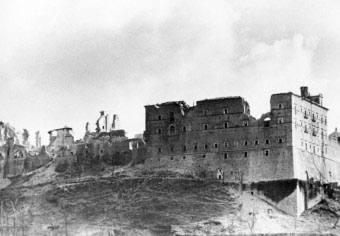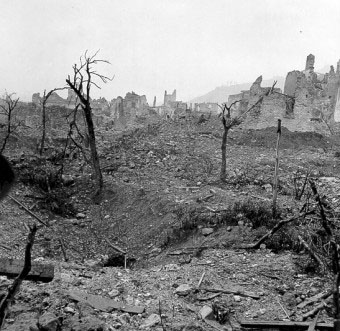Monte Cassino was the cornerstone of the German defensive system known as the Gustav Line and, while it remained intact, it prevented any further advance on Rome from the south by the US 5th and British 8th Armies. Not since 536 AD had any army ever succeeded in capturing Rome from the south.
Meanwhile, Allied forces on the beachhead at Anzio north of Cassino, which was established in an attempt to outflank Cassino and the Gustav Line, had become bogged down and unable to advance further. For these two forces to link up and capture Rome, Cassino remained the key and had to be captured if the Gustav Line was to be breached and the liberation of Italy continue.
To conquer Monte Cassino and the ancient Benedictine monastery that towered above the town required one of Western Europe’s largest and most costly land battles of the Second World War.

As has been recorded in the previous episode, the struggle for Cassino began on 17th January and the final and ultimately successful attack started on 16th May – four months later. After two days of unrelenting assault and some of the fiercest hand to hand fighting of the entire Italian campaign, the German defenders, who were mostly paratroopers, began to retreat from the ruins of the monastery and what remained of the shattered town below and for the first time Allied troops were able to advance along the Liri Valley. But it was an orderly fighting withdrawal by a tenacious enemy.
The road to Rome was now open but it had come at a terrible cost, over two thousand British troops having perished as had thousands of Americans, together with Poles and forces from a number of other nations and nationalities including some from Morocco. The French 2nd Moroccan Division crossed supposedly impassable mountains to outflank and scatter the German 71st Division and although suffering grievously took many prisoners.

The Germans had not been idle during the long and costly struggle for Cassino, having established a second series of fortifications known as the Caesar Line north of Anzio and south of Rome and prepared an even more formidable set of fortifications further north at the foot of the Apennine mountains. These stretched across the whole width of the Italian peninsular from the Adriatic in the east to the distant Ligurian Sea on the west coast and were known as the Gothic Line. This second series of defences was designed to protect the Po valley and the industrial heartland of Italy and claimed to be even more formidable than those at Cassino. Field Marshal Kesselring, the German Commander in Chief South, assured Hitler that the Gothic Line was impregnable.
Rome was still in darkness when, early on 4th June, the first patrols of the US 5th Army cautiously made their way across the river Tiber and along the Via di Conciliazione to St. Peter’s Square in the centre of the city. But it was not until later in the morning that they could be sure that the Eternal City was secure and had been left largely unscathed by the retreating Germans. Earlier both combatants had declared Rome an ‘open city’ but no one knew whether the occupiers would honour that undertaking or wreak a terrible revenge on Rome as they had when they withdrew from Naples the previous October.
With the capture of Rome, the first of the three major Axis capitals had fallen to Allied forces and the liberation of Europe had truly begun.
Once the population was confident the hated Germans had left – street fighting continued in the suburbs for some hours as German rearguards withdrew – suddenly there was a great outpouring of relief and jubilation as two million Romans poured on to the streets to greet the liberators. Three huge flags –Italian, British and American – were hung from the Campidoglio (town hall) and General Mark Clark, the American Fifth Army Commander, received a tumultuous welcome from the crowds as he drove into the city. The commander of the British 8th Army, General Oliver Leese, was busily attempting to outflank the retreating German 10th Army but without success, and the Allied Commander-in Chief, General Harold Alexander, was nowhere to be seen. For obvious political reasons, the liberation of Rome was always intended to be seen as a triumph of US arms.
The Pope, speaking from the balcony of St Peter’s declared: ‘Yesterday Rome was trembling for her sons and daughters. Today she is able to look with renewed hope and faith for her salvation.’
Certainly it was a moment of joyous relief but the battle for the rest of Italy still had to be fought and won and the Germans had no intention of abandoning their aim of tying down as many Allied forces as possible in the hope of delaying the expected invasion of France.
German propaganda tried to make the best of leaving Rome intact, declaring that it had no strategic value; which was true, conveniently ignoring the huge psychological significance its capture would have on the rest of occupied Europe and went on to describe Hitler as ‘the saviour of the Eternal City’. The Allies had yet to discover the gruesome evidence of the 335 hostages shot by the SS in the Ardeatine caves near the city and learn of the thousands of Jews rounded-up and sent to death camps to understand the reality and true cost of Nazi occupation.
On the 6th June 1944, two days after the capture of Rome, British and American forces began landing on the Normandy beaches in the greatest land, sea and air invasion the world had ever seen. ‘Operation Overlord’, the invasion and liberation of Europe, had begun.
As the two Allied armies moved slowly north towards the new German defences and the Gothic line, the following questions were uppermost in everyone’s mind. Would the Italian campaign now be relegated to a secondary role in the pursuit of victory in Europe and given less priority when it came to men and equipment? Would the liberation of the rest of Italy be pursued as vigorously as in the past? Or would it become more a battle of attrition and containment, intending to tie-up forces that otherwise could be used to help repel the Allied landings in France? Paradoxically, this was precisely what the Germans had been endeavouring to do ever since the Allies first set foot in mainland Italy.
There were even suggestions that troops might actually be withdrawn from Italy to mount a second landing in southern France.
Was this feasible? This we were about to discover.
Contact Brian Burton about this article.






